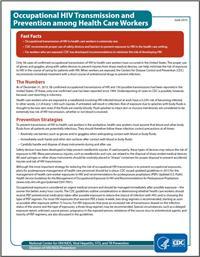This information sheet provides recommendations from the CDC regarding the prevention of occupational transmission of HIV to health care workers (HCWs). The primary means of preventing the HCW's occupational exposure to HIV is to follow infection control precautions with the assumption that the blood and other body fluids from all patients are potentially infectious. Plans for postexposure management of HCWs should be in place, and the administration of antiretroviral drugs as postexposure prophylaxis (PEP) should be considered. CDC has issued guidelines for the management of HCW exposures to HIV and recommendations for PEP. Continued work in the following areas is needed to reduce the risk of occupational HIV transmission to HCWs: administrative efforts (e.g., training and monitoring HCWs on infection control measures), develop and promote the use of safety devices, and monitor the effects of PEP.
Format:
Information Sheet
Publication Date:
2015
ID:
36122
- Educators
- Nurses
- Physicians
- HIV and AIDS
- HIV


